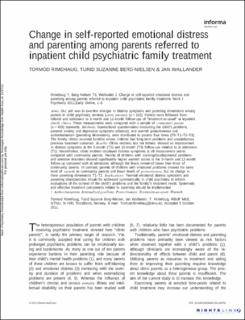| dc.contributor.author | Rimehaug, Tormod | |
| dc.contributor.author | Berg-Nielsen, Turid Suzanne | |
| dc.contributor.author | Wallander, Jan Lance | |
| dc.date.accessioned | 2023-03-20T09:23:00Z | |
| dc.date.available | 2023-03-20T09:23:00Z | |
| dc.date.created | 2011-11-17T12:10:23Z | |
| dc.date.issued | 2012 | |
| dc.identifier.citation | Nordic Journal of Psychiatry. 2012, 66 (4), 260-267. | en_US |
| dc.identifier.issn | 0803-9488 | |
| dc.identifier.uri | https://hdl.handle.net/11250/3059152 | |
| dc.description.abstract | Aims: Our aim was to examine changes in distress symptoms and parenting dimensions among parents in child psychiatry services (clinic parents) (n = 102). Parents were followed from referral and admission to 3-month and 12-month follow-ups of “treatment-as-usual” at inpatient family clinics. These measurements were compared with a sample of community parent (n = 439) standards. Methods: Standardized questionnaires measuring the child's problems, parental anxiety and depression symptoms (distress), and warmth protectiveness and authoritarianism (parenting dimensions), were distributed to parents four times (T0–T1–T2–T3). The family clinics received families whose children had long-term problems and unsatisfactory previous treatment outcomes. Results: Clinic mothers, but not fathers, showed an improvement in distress symptoms at the 3-month (T2) and 12-month (T3) follow-ups relative to at admission (T1). Nevertheless, clinic mothers displayed distress symptoms at all measurement points compared with community parents. Parents of children with learning/developmental problems and attention disorders showed significantly higher warmth scores at the 3-month and 12-month follow-up compared with at admission, although the levels remained lower than those of community parents. In contrast, parents of children with emotional problems showed the same level of warmth as community parents and lower levels of protectiveness, but no change in these parenting dimensions T1–T2. Implications: Parental emotional distress symptoms and parenting characteristics should be addressed systematically in child psychiatry to inform evaluations of the context of the child's problems and the family's treatment needs. Systematic and effective treatment components related to parenting should be implemented. | en_US |
| dc.description.abstract | Change in self-reported emotional distress and parenting among parents referred to inpatient child psychiatric family treatment | en_US |
| dc.language.iso | eng | en_US |
| dc.publisher | Informa UK Limited | en_US |
| dc.rights | Navngivelse 4.0 Internasjonal | * |
| dc.rights.uri | http://creativecommons.org/licenses/by/4.0/deed.no | * |
| dc.title | Change in self-reported emotional distress and parenting among parents referred to inpatient child psychiatric family treatment | en_US |
| dc.title.alternative | Change in self-reported emotional distress and parenting among parents referred to inpatient child psychiatric family treatment | en_US |
| dc.type | Journal article | en_US |
| dc.type | Peer reviewed | en_US |
| dc.description.version | publishedVersion | en_US |
| dc.source.pagenumber | 260-267 | en_US |
| dc.source.volume | 66 | en_US |
| dc.source.journal | Nordic Journal of Psychiatry | en_US |
| dc.source.issue | 4 | en_US |
| dc.identifier.doi | 10.3109/08039488.2011.630752 | |
| dc.identifier.cristin | 859199 | |
| cristin.ispublished | true | |
| cristin.fulltext | original | |
| cristin.qualitycode | 1 | |

